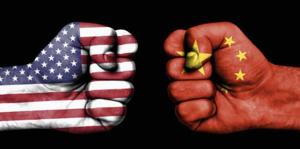No Breakthroughs in China Trade Talks is Good News

That U.S. trade negotiators returned from China last week without trumpeting some big breakthrough is, in fact, a sign of real progress. That’s because there’s no point in touting more cheap promises that won’t be kept.
The U.S. and China discussed complex, long-standing trade disputes that have contributed significantly to America’s relentlessly expanding trade deficit with the Asian giant, to the shuttering of tens of thousands of U.S. factories, and to the loss of hundreds of thousands of good-paying American jobs.
The U.S. delegation traveled to Beijing with a four-page list of demands, as well as sufficient scarring from past burns to ignore shiny objects this time. The American demands are tough, and completely appropriate. Rebalancing trade with China, which is $375 billion out of whack, will not be easy.
Talk certainly is better than a trade war, which was threatened when China said it would match tit-for-tat penalties and tariffs the Trump administration levied for trade violations. No one wants to see American soybean farmers hurt by tariffs imposed by China in retaliation for tariffs the United States placed on steel and aluminum imports.
But Americans don’t want to sit idly by like patsies, either, while China violates international trade regulations, cyber-hacks intellectual property, destroys American manufacturing and damages with its predatory and protectionist policies U.S. farmers trying to export agricultural products.
Fair resolution of these disputes with China is crucial to members of the union I lead, the United Steelworkers (USW). China’s violation of trade laws has closed steel mills and aluminum smelters, forced the layoffs of tens of thousands of these workers and bankrupted small towns and school districts that depended on tax revenue from factories now shuttered.
The U.S. Commerce Department investigated Chinese trade practices in steel and aluminum for nearly a year before telling President Trump in January that Beijing’s trade law violations had so diminished America’s capacity to produce aluminum and steel that national security was threatened. Commerce Secretary Wilbur Ross recommended penalties. On March 1, President Trump imposed tariffs of 25 percent on imported steel and 10 percent on imported aluminum.
This followed the administration placing tariffs on imported solar panels and washing machines. And it preceded Trump announcing 25 percent tariffs on $50 billion worth of Chinese imports, mostly high-tech products. This was because an investigation by U.S. Trade Representative Robert Lighthizer found that China was stealing intellectual property from American companies.
The USW, and three of its employers, Alcoa, U.S. Steel, and specialty steel company Allegheny Technologies, as well as SolarWorld and Westinghouse Electric Co., were victims of that theft.
In 2014, a grand jury indicted five Chinese military hackers for economic espionage and other offenses against the USW and the five corporations. In some cases, the indictment says, the conspirators stole trade secrets that were particularly beneficial to Chinese companies at the time they were taken. In other cases, it says, the five conspirators stole sensitive, internal communications that would provide a competitor, or an adversary in litigation, with insight into the strategy and vulnerabilities of the American entity.
This is hardly the only case of theft by cyber hacking that allowed Chinese companies, without paying a cent, to benefit from billions of dollars in American research and technological advances.
Just hours after the Trump administration announced the tariffs on high-tech imports from China, Beijing said it would impose the same penalties on U.S. exports to China, including soybeans and Boeing planes.
To prevent further escalation, the two sides met in Beijing last week. But the Americans, including Treasury Secretary Steven Mnuchin, Commerce Secretary Ross, Trade Representative Lighthizer and Trump’s trade director Peter Navarro, presented tough demands that made it clear these negotiators knew how many vows of cooperation the Chinese have failed to fulfill.
For example, China has created a massive overcapacity to forge steel, a strategy that keeps its citizens employed. Because of the excess production, China dumps on the international market more than 100 million tons of underpriced steel a year.
Chinese steel companies receive improper government subsidies that enable them to sell at prices below the cost to produce the metal. That artificially cheap steel drags down the price internationally, which, in turn, has bankrupted mills in the United States, Canada, Britain, Spain and other countries.
China has promised repeatedly – at least six times since 2009 – that it would eliminate excess steelmaking capacity. Instead, it has increased capacity.
So, frankly, its promises are worthless. Under those circumstances, the stiff demands from the American delegation are completely justified. They include ending China’s free-market-distorting subsidies, terminating cyber attacks and cyber thefts and decreasing its tariffs to levels no higher than those charged by the United States.
In addition, the United States is demanding a reduction of at least $200 billion in the U.S. trade deficit with China by 2020.
That deficit last year was $375 billion, the highest ever. And it continues to grow. The record-high first quarter 2018 trade deficit with China of $91.1 billion is more than $10 billion higher than it was for the same quarter last year.
Last year’s trade deficit with China accounted for two-thirds of America’s $566 billion trade deficit with the entire world. It is a transfer of wealth from the United States to China, and when it’s caused in part by cyber hacking, it’s the theft of wealth. The trade deficit in advanced technology products with China is more than $100 billion.
That’s unacceptable.
The problem is both the size and composition of the trade deficit. So, for example, reducing the deficit by securing the right to sell $100 billion in insurance to China is not an acceptable solution. That would create precious few jobs.
The massive trade imbalance must be remedied by China participating in the international market as a good-faith player, one that abides by the international rules required of World Trade Organization members, and one that will accept measures to verify that it is operating legally.
The American trade envoys are engaged in a long negotiation with China. And over the weekend, the Trump administration made clear it has no intention of caving to Chinese demands. The White House described as “Orwellian nonsense” a demand from China’s Civil Aviation Administration that 36 foreign airlines, including those in the United States, remove from their websites any indication that Taiwan, Hong Kong and Macau are independent from China.
The U.S. strategy is appropriate because these are thorny matters and past pledges extracted from China have produced no bona fide or enduring results.


